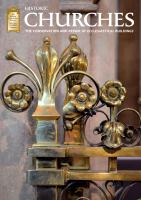

BCD SPECIAL REPORT ON
HISTORIC CHURCHES
22
ND ANNUAL EDITION
33
This three-year, £1.2 million project
is primarily supported by the HLF, which
recognised the value of pooling volunteer
resources that the project presented.
The idea is simple: bring together a
number of places of worship in an area
and help them put together a trained
group of volunteers which can carry out
preventive (non-invasive) maintenance,
sharing equipment and expertise, and
saving time and money.
In order to achieve this the SPAB has
assembled an eight-strong team, including
five regionally based project officers,
each working to found co-operatives in
their area and support them over the life
of the project with training, volunteer
recruitment and organisation. The project
also has its own dedicated technical
officer, James Innerdale, an architect with
long experience of the society’s technical
work. The team is supported by an
administrator and project manager.
Each place of worship that takes
part receives an information and launch
event given by their regional officer,
and a baseline survey day. James has
developed an easy-to-use survey tool
that can be downloaded free of charge
from the MCP website
(www.spabmcp.org.uk/co-op-toolkit). The tool is
designed to assess the condition of each
part of the building and the associated
training helps volunteers to understand
what needs to be done to keep it in
good condition and, crucially, to spot
small issues well before they become big
expensive problems. Often this can be as
simple as matching a green patch inside
with a cracked gutter outside. Finding it
early can mean the difference between a
quick gutter repair and an expensive roof
timber replacement – or worse.
Once the survey is complete, the
findings are used to compile an annual
maintenance plan and to establish what is
needed to carry out the plan. That might
be volunteer recruitment, equipment
sharing or tailored training days.
The idea is to distil what can be a
never-ending and daunting task into
a simple and planned set of activities
which participants have the confidence
to carry out. It is not designed to
encourage non-specialists to carry out
invasive or corrective work to buildings.
In fact quite the opposite, the project
can’t always prevent the big jobs, they
still inevitably crop up or are already
present. When needed, the MCP team
can help participants understand what
needs to be done, how to employ – with
professional support – an appropriately
qualified and priced contractor
who understands the needs of their
building and, if necessary, help them to
understand the faculty system.
Where a specialist contractor is
needed the cost can be spread if other
buildings in the co-operative need
similar work, an idea already successfully
promoted by SPAB allies Maintain Your
Heritage through their ‘GutterClear’
programme. Where a building has a
quinquennial inspection regime the MCP
survey and maintenance plan is designed
to work alongside it, referencing its
findings and dealing with issues that
might crop up within a five year period.
At the end of the project’s first year
approximately 20 co-operatives are up and
running across the five project regions:
South West, North East, Herefordshire
and Worcestershire, Lincolnshire, and
Cumbria. Over 40 events have taken
place attracting a total of around 600
delegates. It has been quite a learning
curve. What a co-operative looks like,
how many buildings take part, how it is
run and the type of activities it carries
out vary widely from place to place. This
gives a strong local flavour to each group
and means that the project responds to
local needs, but it also means that the
MCP team needs to approach each new
co-operative slightly differently, getting to
understand what they want to get out of
being involved.
A co-operative in Cumbria is
responsible for the fragile William Morris
Lanercost Dossal, an embroidered
wall-hanging of exceptional artistic
and historical significance. The team
there has emphasised what is essentially
collections care, taking part in textile
conservation training that has given them
the confidence to understand the highly
sensitive annual cleaning programme.
In the South West the Melbury Team
co-operative started out with a series
of practical gutter clearing days.
The Herefordshire and Worcestershire
region has seen co-operatives
mushrooming all over the two counties as
word about the benefits of co-operative
working spreads. A local steering group
is in place and volunteers have been
pro-active in creating the survey and
maintenance plan at each building taking
part. Many are current places of worship
but others have had to find alternative
uses, including as a scout hut. The
need for well-planned and appropriate
preventive maintenance, however,
remains the same.
Once a year the Maintenance
Co-operatives Project holds a national
conference to launch National
Maintenance Week. The conference is
an opportunity to bring together people
who have been involved from all over the
country, celebrate their achievements,
share ideas and discuss challenges. Like all
MCP training and events the conference
is free to attend and open to anyone who
is interested in maintaining places of
worship of any faith, be they old, listed,
historic or otherwise.
The one-day national conference
features speakers from a range of
backgrounds, covering everything
from faculties to heating, and gutters
to gravestones. In the afternoon
delegates have the opportunity to
book a maintenance surgery with an
MCP specialist or join a local tour.
Whichever they choose, everyone ends
up enjoying a sociable drink in the
evening. It is a great way to meet people
from across the country who share the
same challenges. The 2015 conference
will be in Birmingham on Friday 20th
November. Booking will open at the end
of the summer and a limited number of
bursaries will be available to help cover
the travel expenses of volunteers who
have some distance to travel.
It is hoped that at the end of the
project the co-operatives that have
been established with the support of
the MCP regional officers will continue
under their own steam, but also that
other co-operatives will adopt the model
independently. The project website
(www.spabmcp.org.uk), complete with
‘how to set-up a co-operative toolkit’,
downloadable tools and technical advice
will remain live, and as ever the main
SPAB technical helpline will be available
to answer questions over the phone
about maintaining your place of worship.
KATE STREETER
joined the SPAB in 2013
as project manager for the Maintenance
Co-operatives Project
(www.spabmcp.org.
uk), having spent the previous six years as
manager of Burgh House and Hampstead
Museum and founding chair of London
Small Historic Houses. She also works as a
freelance museums and heritage consultant.
Spotting and responding to minor defects quickly
can prevent them from developing into larger, more
expensive problems.
















